+ データを開く
データを開く
- 基本情報
基本情報
| 登録情報 | データベース: PDB / ID: 5fxh | ||||||
|---|---|---|---|---|---|---|---|
| タイトル | GluN1b-GluN2B NMDA receptor in non-active-1 conformation | ||||||
 要素 要素 |
| ||||||
 キーワード キーワード | TRANSPORT PROTEIN / SIGNALING PROTEIN / NMDA RECEPTOR / GLUTAMATE RECEPTOR / GLUN1 / GLUN2B / ION CHANNEL | ||||||
| 機能・相同性 |  機能・相同性情報 機能・相同性情報cellular response to curcumin / cellular response to corticosterone stimulus / cellular response to magnesium starvation / sensory organ development / pons maturation / positive regulation of Schwann cell migration / regulation of cell communication / sensitization / EPHB-mediated forward signaling / Assembly and cell surface presentation of NMDA receptors ...cellular response to curcumin / cellular response to corticosterone stimulus / cellular response to magnesium starvation / sensory organ development / pons maturation / positive regulation of Schwann cell migration / regulation of cell communication / sensitization / EPHB-mediated forward signaling / Assembly and cell surface presentation of NMDA receptors / response to hydrogen sulfide / auditory behavior / olfactory learning / conditioned taste aversion / dendritic branch / regulation of respiratory gaseous exchange / response to other organism / protein localization to postsynaptic membrane / regulation of ARF protein signal transduction / fear response / apical dendrite / transmitter-gated monoatomic ion channel activity / positive regulation of inhibitory postsynaptic potential / suckling behavior / response to methylmercury / response to glycine / propylene metabolic process / response to manganese ion / response to carbohydrate / interleukin-1 receptor binding / negative regulation of dendritic spine maintenance / cellular response to dsRNA / response to growth hormone / cellular response to lipid / heterocyclic compound binding / regulation of monoatomic cation transmembrane transport / NMDA glutamate receptor activity / positive regulation of glutamate secretion / RAF/MAP kinase cascade / Synaptic adhesion-like molecules / voltage-gated monoatomic cation channel activity / response to glycoside / NMDA selective glutamate receptor complex / glutamate binding / ligand-gated sodium channel activity / neurotransmitter receptor complex / response to morphine / calcium ion transmembrane import into cytosol / regulation of axonogenesis / neuromuscular process / regulation of dendrite morphogenesis / protein heterotetramerization / male mating behavior / glycine binding / regulation of synapse assembly / response to amine / small molecule binding / regulation of cAMP/PKA signal transduction / parallel fiber to Purkinje cell synapse / receptor clustering / startle response / positive regulation of reactive oxygen species biosynthetic process / monoatomic cation transmembrane transport / behavioral response to pain / positive regulation of calcium ion transport into cytosol / regulation of MAPK cascade / response to magnesium ion / regulation of neuron apoptotic process / regulation of postsynaptic membrane potential / cellular response to glycine / associative learning / action potential / extracellularly glutamate-gated ion channel activity / monoatomic cation transport / excitatory synapse / positive regulation of dendritic spine maintenance / response to electrical stimulus / social behavior / regulation of neuronal synaptic plasticity / monoatomic ion channel complex / glutamate receptor binding / positive regulation of excitatory postsynaptic potential / Unblocking of NMDA receptors, glutamate binding and activation / response to mechanical stimulus / long-term memory / detection of mechanical stimulus involved in sensory perception of pain / synaptic cleft / neuron development / behavioral fear response / positive regulation of synaptic transmission, glutamatergic / prepulse inhibition / phosphatase binding / multicellular organismal response to stress / postsynaptic density, intracellular component / monoatomic cation channel activity / calcium ion homeostasis / response to fungicide / glutamate-gated receptor activity / cell adhesion molecule binding / D2 dopamine receptor binding 類似検索 - 分子機能 | ||||||
| 生物種 |  | ||||||
| 手法 | 電子顕微鏡法 / 単粒子再構成法 / クライオ電子顕微鏡法 / 解像度: 5 Å | ||||||
 データ登録者 データ登録者 | Tajima, N. / Karakas, E. / Grant, T. / Simorowski, N. / Diaz-Avalos, R. / Grigorieff, N. / Furukawa, H. | ||||||
 引用 引用 |  ジャーナル: Nature / 年: 2016 ジャーナル: Nature / 年: 2016タイトル: Activation of NMDA receptors and the mechanism of inhibition by ifenprodil. 著者: Nami Tajima / Erkan Karakas / Timothy Grant / Noriko Simorowski / Ruben Diaz-Avalos / Nikolaus Grigorieff / Hiro Furukawa /  要旨: The physiology of N-methyl-d-aspartate (NMDA) receptors is fundamental to brain development and function. NMDA receptors are ionotropic glutamate receptors that function as heterotetramers composed ...The physiology of N-methyl-d-aspartate (NMDA) receptors is fundamental to brain development and function. NMDA receptors are ionotropic glutamate receptors that function as heterotetramers composed mainly of GluN1 and GluN2 subunits. Activation of NMDA receptors requires binding of neurotransmitter agonists to a ligand-binding domain (LBD) and structural rearrangement of an amino-terminal domain (ATD). Recent crystal structures of GluN1-GluN2B NMDA receptors bound to agonists and an allosteric inhibitor, ifenprodil, represent the allosterically inhibited state. However, how the ATD and LBD move to activate the NMDA receptor ion channel remains unclear. Here we applied X-ray crystallography, single-particle electron cryomicroscopy and electrophysiology to rat NMDA receptors to show that, in the absence of ifenprodil, the bi-lobed structure of GluN2 ATD adopts an open conformation accompanied by rearrangement of the GluN1-GluN2 ATD heterodimeric interface, altering subunit orientation in the ATD and LBD and forming an active receptor conformation that gates the ion channel. | ||||||
| 履歴 |
|
- 構造の表示
構造の表示
| ムービー |
 ムービービューア ムービービューア |
|---|---|
| 構造ビューア | 分子:  Molmil Molmil Jmol/JSmol Jmol/JSmol |
- ダウンロードとリンク
ダウンロードとリンク
- ダウンロード
ダウンロード
| PDBx/mmCIF形式 |  5fxh.cif.gz 5fxh.cif.gz | 427.5 KB | 表示 |  PDBx/mmCIF形式 PDBx/mmCIF形式 |
|---|---|---|---|---|
| PDB形式 |  pdb5fxh.ent.gz pdb5fxh.ent.gz | 276.3 KB | 表示 |  PDB形式 PDB形式 |
| PDBx/mmJSON形式 |  5fxh.json.gz 5fxh.json.gz | ツリー表示 |  PDBx/mmJSON形式 PDBx/mmJSON形式 | |
| その他 |  その他のダウンロード その他のダウンロード |
-検証レポート
| 文書・要旨 |  5fxh_validation.pdf.gz 5fxh_validation.pdf.gz | 838.8 KB | 表示 |  wwPDB検証レポート wwPDB検証レポート |
|---|---|---|---|---|
| 文書・詳細版 |  5fxh_full_validation.pdf.gz 5fxh_full_validation.pdf.gz | 867.5 KB | 表示 | |
| XML形式データ |  5fxh_validation.xml.gz 5fxh_validation.xml.gz | 67.9 KB | 表示 | |
| CIF形式データ |  5fxh_validation.cif.gz 5fxh_validation.cif.gz | 109.7 KB | 表示 | |
| アーカイブディレクトリ |  https://data.pdbj.org/pub/pdb/validation_reports/fx/5fxh https://data.pdbj.org/pub/pdb/validation_reports/fx/5fxh ftp://data.pdbj.org/pub/pdb/validation_reports/fx/5fxh ftp://data.pdbj.org/pub/pdb/validation_reports/fx/5fxh | HTTPS FTP |
-関連構造データ
| 関連構造データ |  3353MC  3352C  3354C  3355C  3356C  5b3jC  5fxgC  5fxiC  5fxjC  5fxkC C: 同じ文献を引用 ( M: このデータのモデリングに利用したマップデータ |
|---|---|
| 類似構造データ |
- リンク
リンク
- 集合体
集合体
| 登録構造単位 | 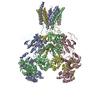
|
|---|---|
| 1 |
|
- 要素
要素
| #1: タンパク質 | 分子量: 95220.727 Da / 分子数: 2 / 断片: UNP RESIDUES 23-868 / 変異: YES / 由来タイプ: 組換発現 / 由来: (組換発現)  発現宿主:  参照: UniProt: P35439 #2: タンパク質 | 分子量: 92931.078 Da / 分子数: 2 / 断片: UNP RESIDUES 27-852 / 変異: YES / 由来タイプ: 組換発現 / 由来: (組換発現)  発現宿主:  参照: UniProt: Q00960 |
|---|
-実験情報
-実験
| 実験 | 手法: 電子顕微鏡法 |
|---|---|
| EM実験 | 試料の集合状態: PARTICLE / 3次元再構成法: 単粒子再構成法 |
- 試料調製
試料調製
| 構成要素 | 名称: NMDA RECEPTOR / タイプ: COMPLEX |
|---|---|
| 緩衝液 | 名称: 200 MM NACL, 20 MM HEPES PH 7.0, 10 MM GLYCINE, 10 MM L-GLUTAMATE, 0.002% MNG-3 pH: 7 詳細: 200 MM NACL, 20 MM HEPES PH 7.0, 10 MM GLYCINE, 10 MM L-GLUTAMATE, 0.002% MNG-3 |
| 試料 | 濃度: 2 mg/ml / 包埋: NO / シャドウイング: NO / 染色: NO / 凍結: YES |
| 試料支持 | 詳細: HOLEY CARBON |
| 急速凍結 | 装置: FEI VITROBOT MARK II / 凍結剤: ETHANE / 詳細: ETHANE |
- 電子顕微鏡撮影
電子顕微鏡撮影
| 実験機器 |  モデル: Titan Krios / 画像提供: FEI Company |
|---|---|
| 顕微鏡 | モデル: FEI TITAN KRIOS / 日付: 2015年8月10日 |
| 電子銃 | 電子線源:  FIELD EMISSION GUN / 加速電圧: 300 kV / 照射モード: FLOOD BEAM FIELD EMISSION GUN / 加速電圧: 300 kV / 照射モード: FLOOD BEAM |
| 電子レンズ | モード: BRIGHT FIELD / 倍率(公称値): 22500 X / 倍率(補正後): 38168 X / 最大 デフォーカス(公称値): 2500 nm / 最小 デフォーカス(公称値): 1000 nm |
| 撮影 | 電子線照射量: 100 e/Å2 フィルム・検出器のモデル: GATAN K2 SUMMIT (4k x 4k) |
- 解析
解析
| 対称性 | 点対称性: C2 (2回回転対称) | ||||||||||||
|---|---|---|---|---|---|---|---|---|---|---|---|---|---|
| 3次元再構成 | 解像度: 5 Å / 解像度の算出法: FSC 0.143 CUT-OFF / 粒子像の数: 15000 / Refinement type: HALF-MAPS REFINED AGAINST SAME DATA / 対称性のタイプ: POINT | ||||||||||||
| 精密化 | 最高解像度: 5 Å | ||||||||||||
| 精密化ステップ | サイクル: LAST / 最高解像度: 6.1 Å
|
 ムービー
ムービー コントローラー
コントローラー



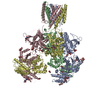

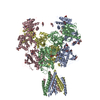



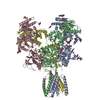

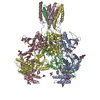
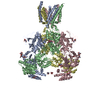
 PDBj
PDBj



